German Bread (Authentic Vollkornbrot)
This post may contain affiliate links. See my disclosure policy.
A thoroughly authentic German Bread Recipe (Vollkornbrot)! This delicious traditional German whole grain seed bread is nutrient dense with a fabulous texture and positively packed with flavor. This makes a large loaf that freezes well so you can conveniently grab some whenever you’re in the mood.
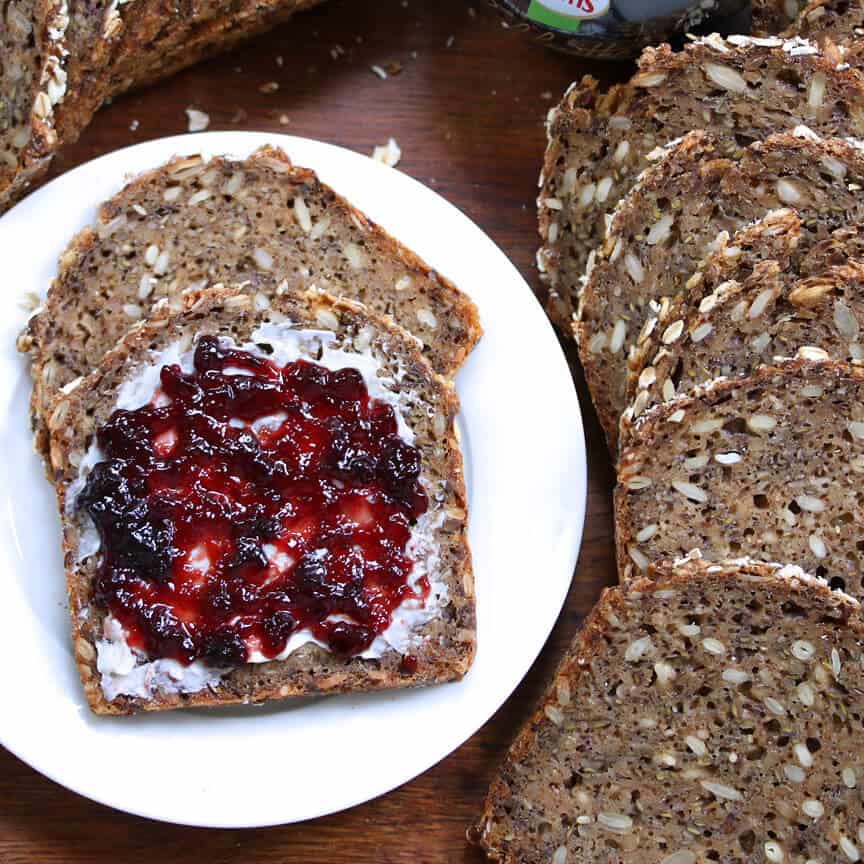
Authentic German Bread (Vollkornbrot)
Few things are better than a freshly baked loaf of bread slathered down with butter and some good jam. That’s true for crusty breads with fluffy interiors and the more hearty, dense breads that I also know and love from Europe. Here is a German bread that is beloved throughout Germany and is also widely enjoyed in Austria and Switzerland. It features a grain called Einkorn that is used throughout much of western Europe, but feel free to substitute other grains according to your preference.
Dense, chewy, packed with nutrition and full of flavor, this whole grain German brown bread (Vollkornbrot) is wonderful with your choice of butter, jam, Nutella, cheese, or cold cuts.
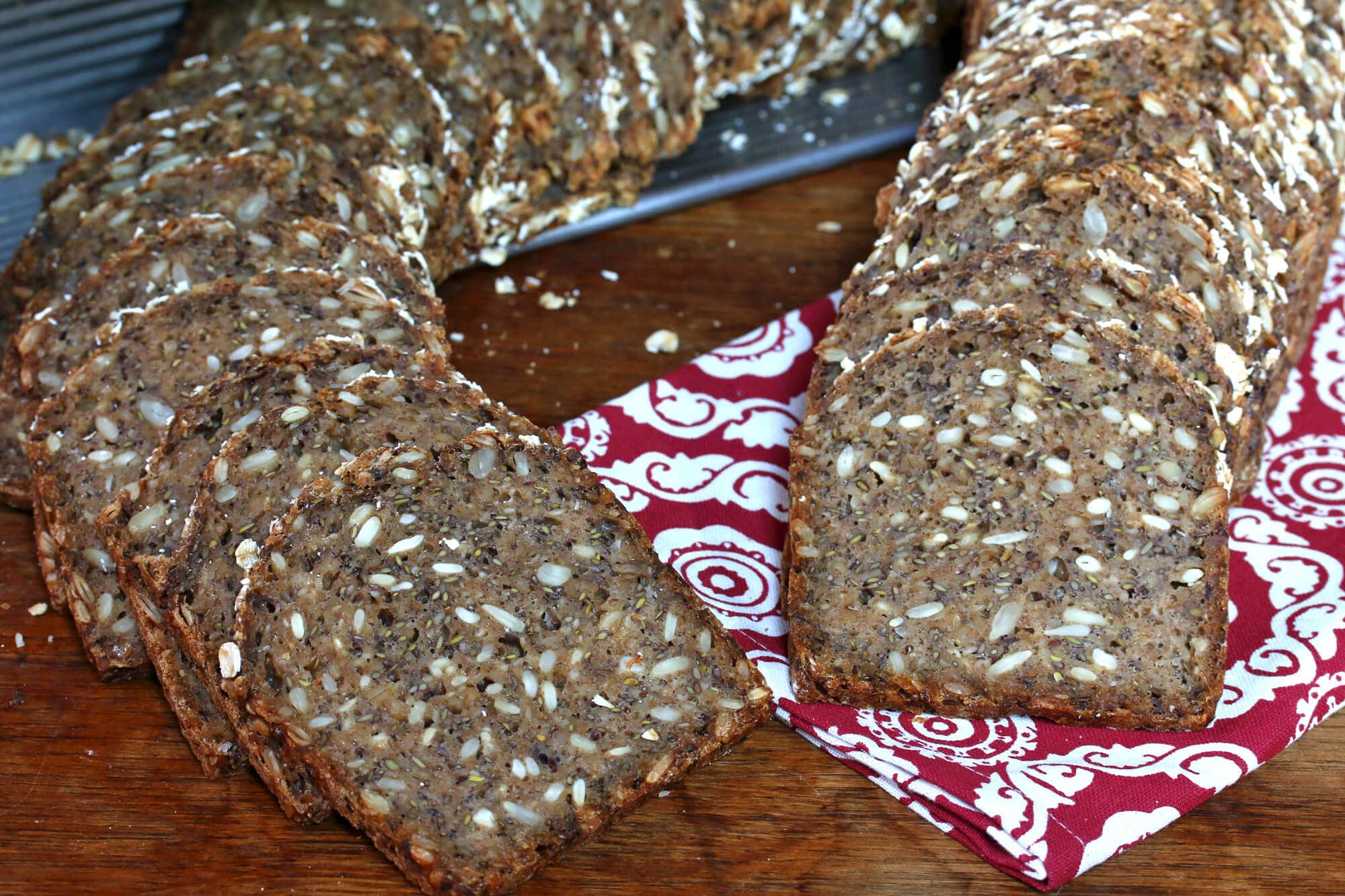
Have you heard of the grain einkorn before? Modern day wheat over the centuries has undergone a series of genetic changes for the purpose of increasing yield and gluten content. It’s almost unidentifiable compared to its ancestor (and my guess is that is why gluten issues are a more recent occurrence). Einkorn is the most ancient form of wheat on earth and hasn’t undergone these genetic changes. It is the purest form of wheat we have. You can purchase einkorn online HERE.
The advantages of einkorn: Most agree it tastes better than wheat and is much easier to digest, even easier than spelt. Compared to the gluten in modern day wheat, it contains a structurally different composition of gluten that the body is able to digest more easily. In fact, some people with gluten issues who have switched to einkorn have found that they’re able to tolerate and digest it with ease.
Even visually there’s a difference between wheat and einkorn. Though there are size variations within different types of wheat, generally most wheat (left) is longer in length than einkorn (right). Einkorn also has a deeper caramel color.
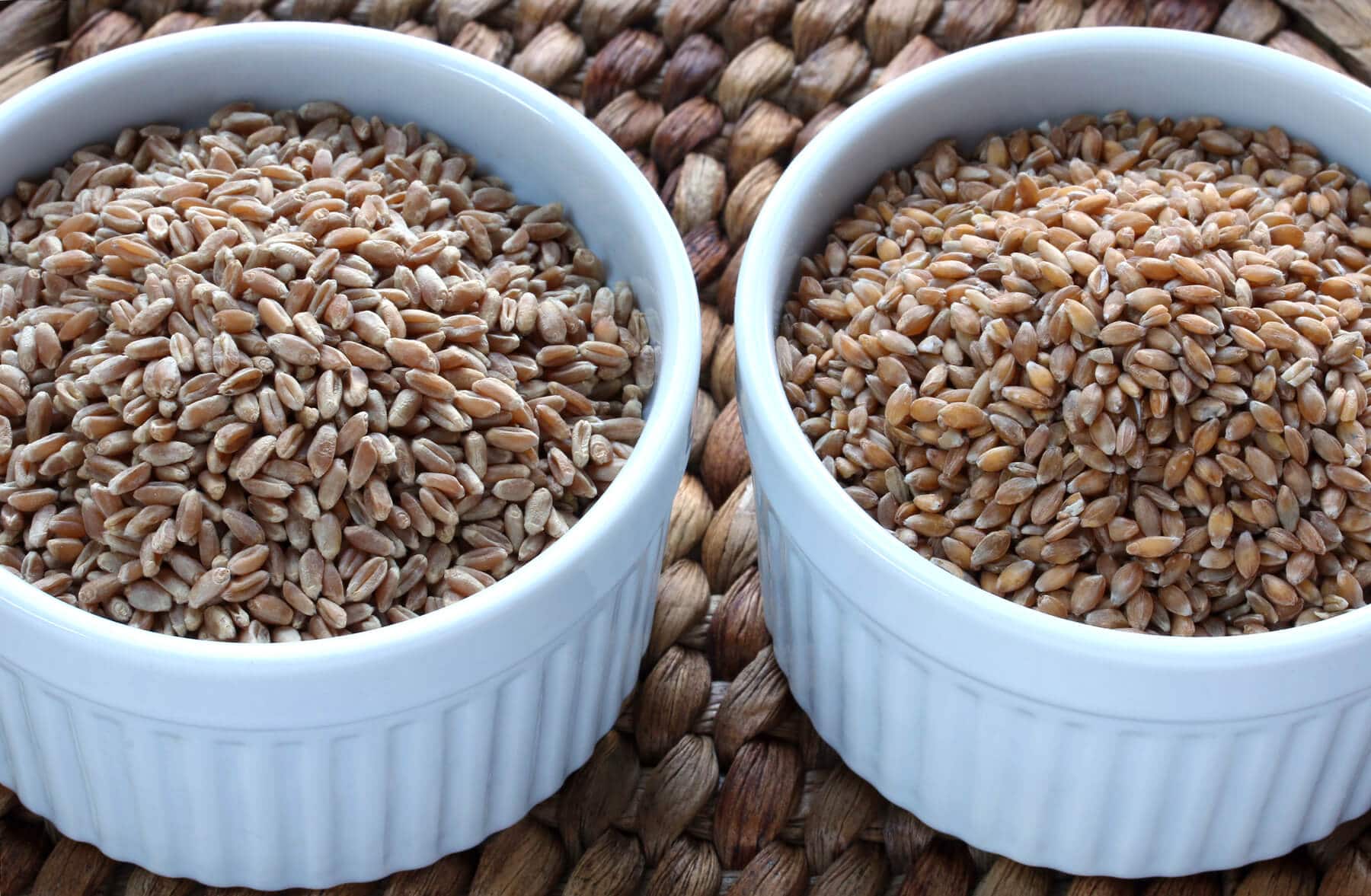
It’s unfortunate that as wonderful as Einkorn is, and common as Einkorn is in many places throughout western Europe, it’s almost unheard of here and very few places sell it. And for that reason it’s also much more expensive here in the U.S.. Hopefully that will change as it becomes more common. The same was true of spelt for a long time and though it’s still far less common than wheat here in the U.S. its price-point has gone down.
I buy all of my grains, including einkorn, in bulk. I take out what I need for a few weeks at a time and store the rest in a dark, cool place. It saves money that way and I have easy access to everything I need. And I LOVE being able to grind my own grains fresh as needed and make up my own fresh baking mixes!
My German-made KoMo grain mill is the pride and joy of my kitchen. German engineering at it’s best, the KoMo grain mill is simply awesome. You can grind your grains as fine or as coarsely as you like. With a 12-year warranty this thing is a work-horse and does a magnificent job. I use it nearly every day grinding my own flours, making cornmeal and a variety of mixes. I cannot recommend it highly enough.
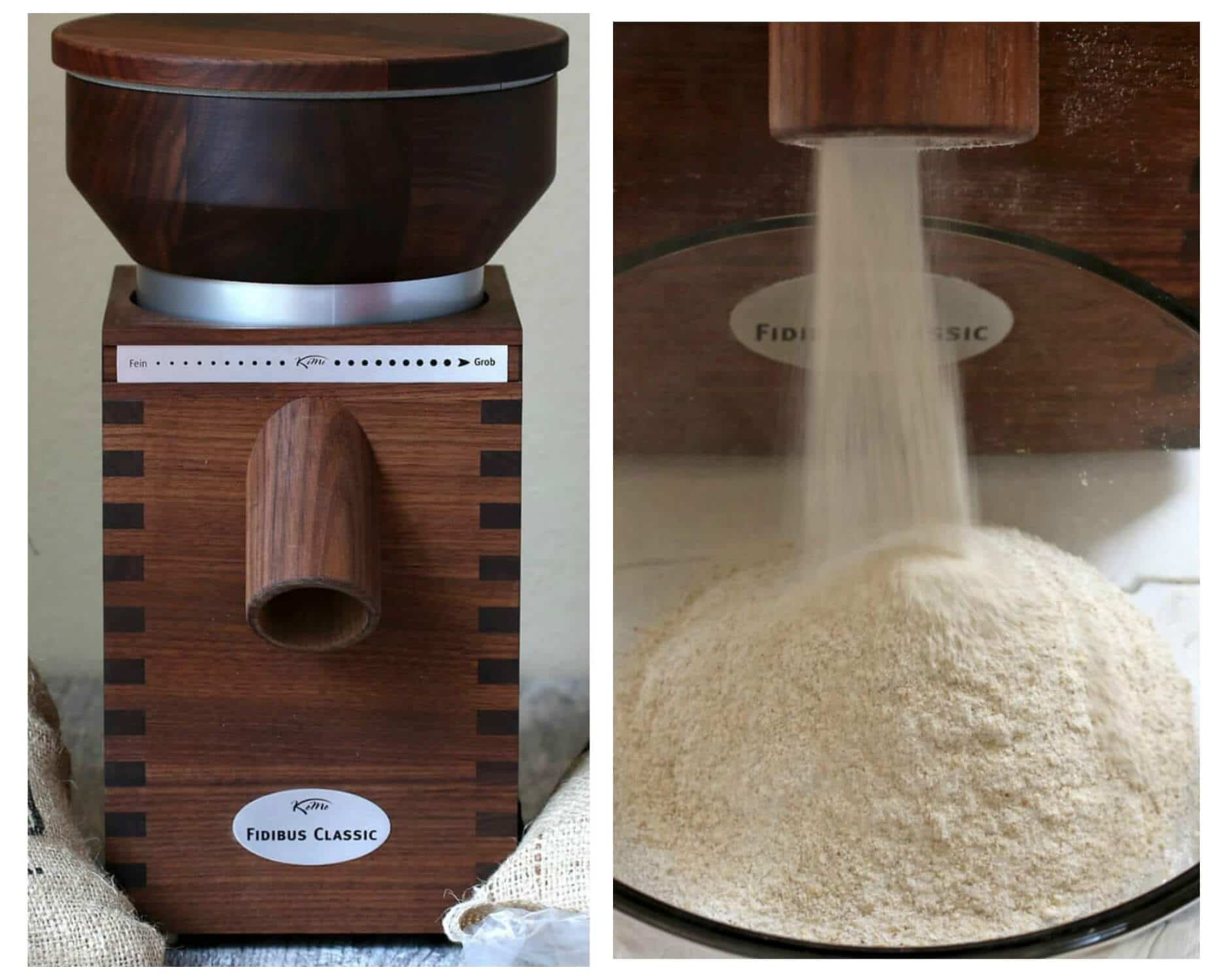
This traditional German bread uses a combination of whole einkorn berries and ground einkorn flour. Whether you’re grinding your own grains or buying the flour already ground, you’re absolutely going to love the texture and flavor of this wonderfully hearty, rustic and thoroughly authentic German bread!
German Sourdough Bread
A couple of our readers have reported back about using sourdough starter instead of yeast. To make this a sourdough Vollkornbrot omit the yeast, add 200 grams of active sourdough starter, and reduce the flour by 100 grams and the water by 100 grams. Give the batter a full 24 hour ferment.
German Bread Recipe (Vollkornbrot)
Let’s get started!
Dissolve the yeast and sugar in the lukewarm water and let sit for 5-10 minutes until frothy. (See above if you prefer to use sourdough starter.)
Place all of the dry ingredients in the bowl of a stand mixer. (You can do this by hand if you prefer.)
NOTE: I personally don’t pre-soak the whole or cracked grain berries and let my batter ferment for a full 24 hours which softens the berries. Depending on the age of the grains you’re using they may require a pre-soaking in order to be adequately soft. If you wish you can pre-soak the grains overnight (pour hot water over them and let them sit) and then thoroughly drain for an hour or so.

Add the yeast mixture along with the buttermilk and beer. Knead on the bread setting (#2) for 10 minutes.
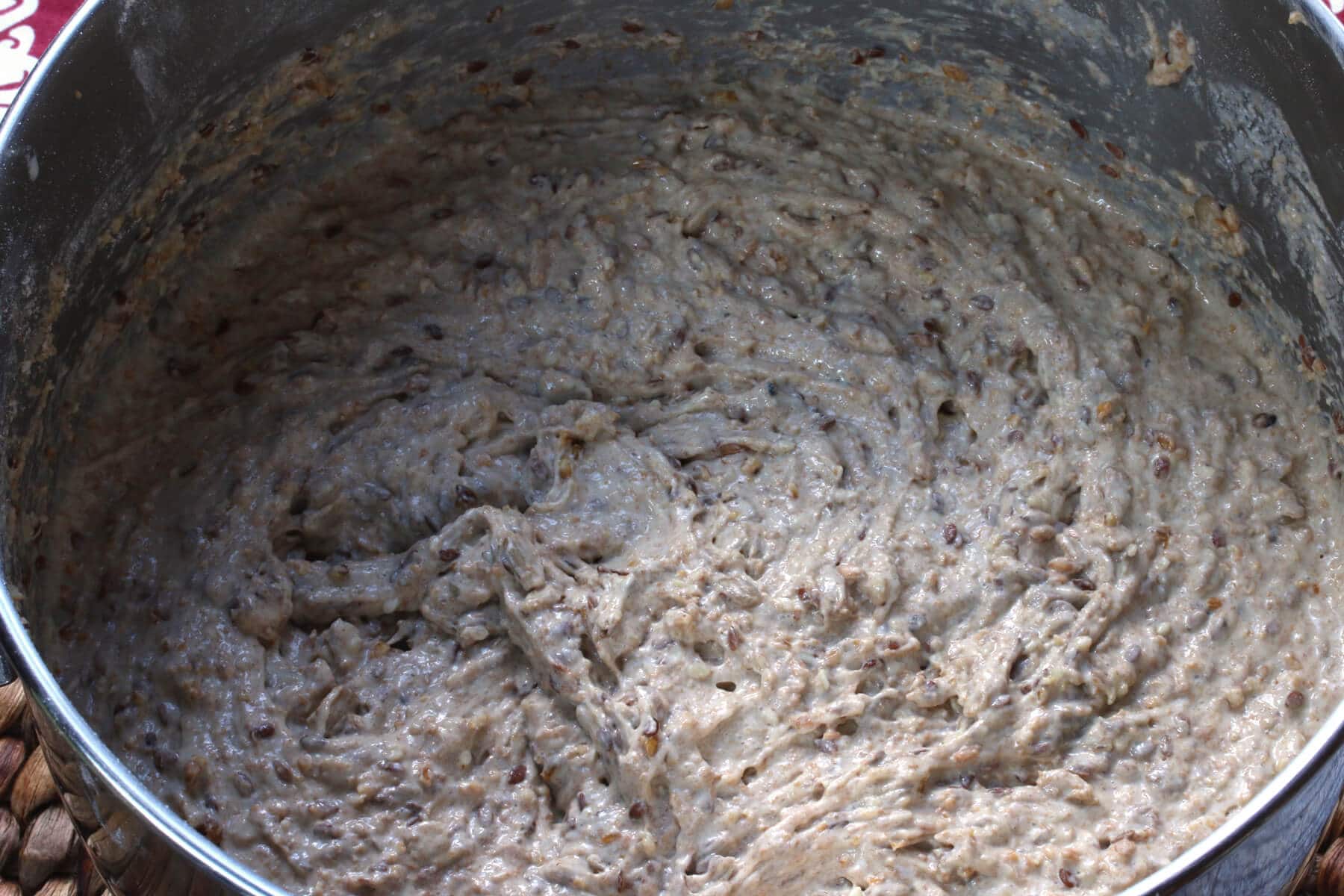
Scoop the mixture into a non-reactive bowl, cover loosely with plastic wrap and let it sit at room temperature for at least 8 hours, preferably longer, up to 24 hours (the longer the better for the whole grain berries to soften and for heightened sourdough properties. If you’re letting it sit for less than 24 hours, presoak the grains overnight in advance and drain thoroughly). Also, the longer it ferments the more liquid will be absorbed so less chances of a moist center after baking.
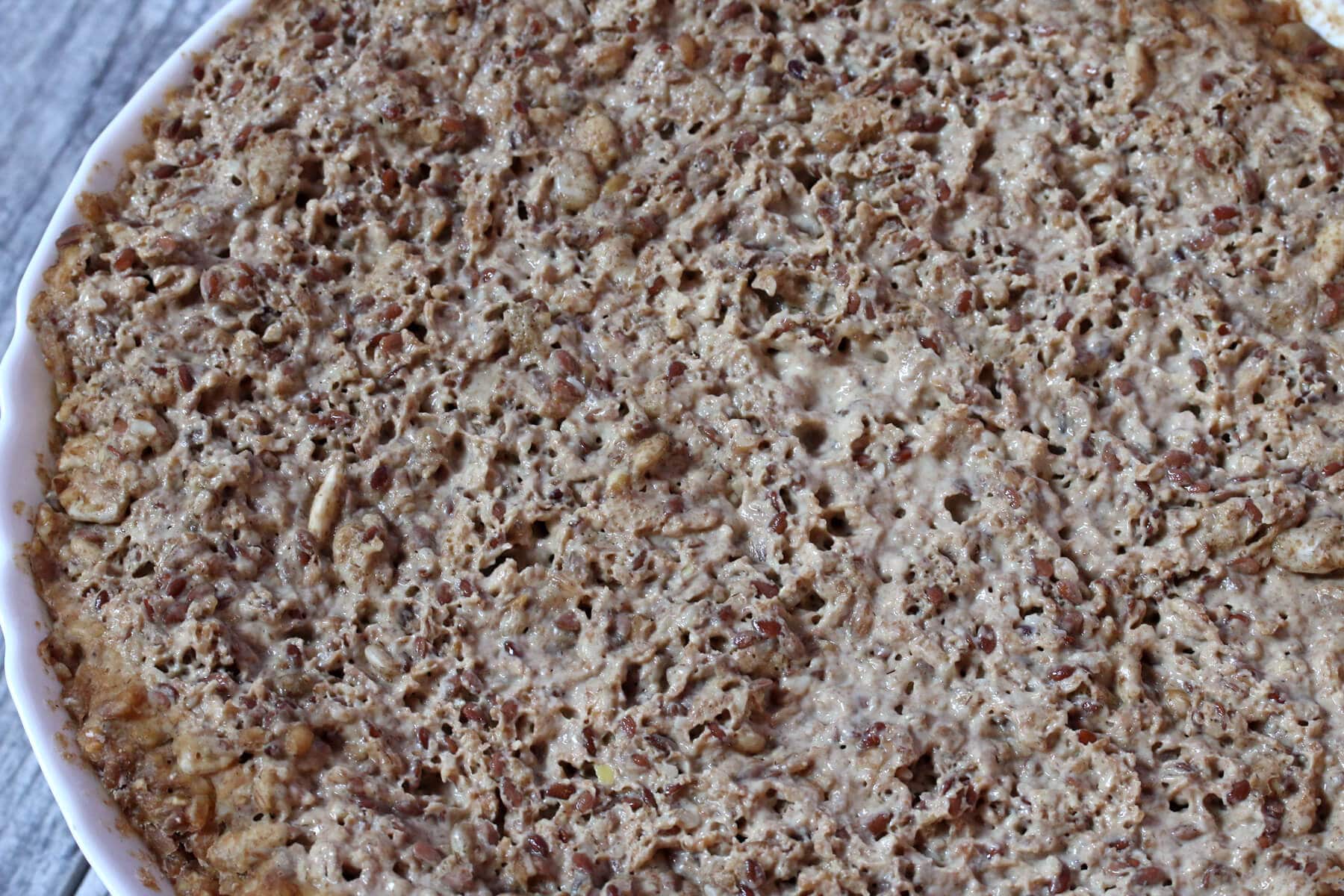
The mixture will be thick and gooey but will not resemble typical bread dough.
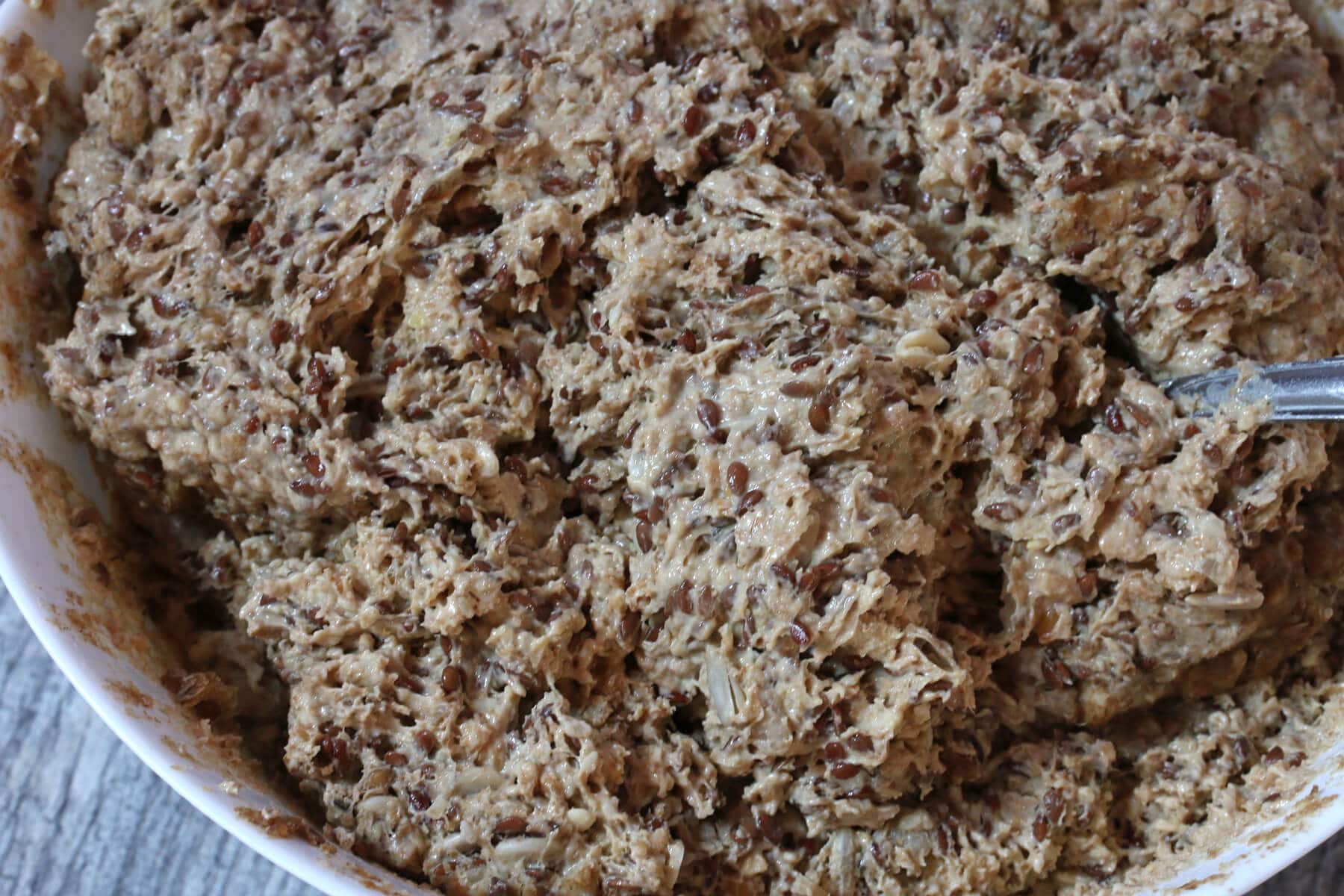
Scoop the mixture into a generously buttered Pullman Loaf Pan and smooth the top so it’s even.
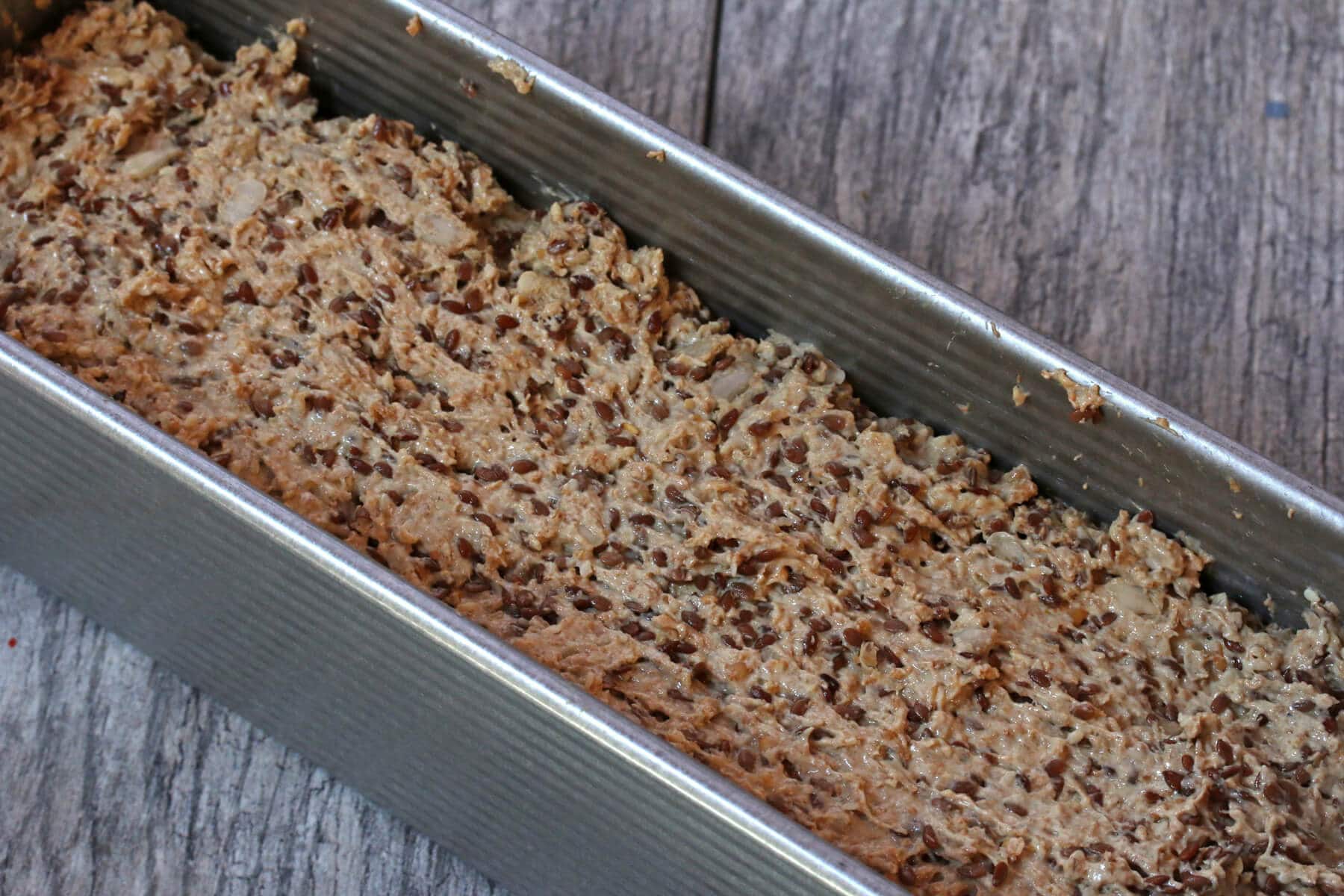
Baking this bread in a Pullman loaf pan yields those nice small, square slices of bread. But it also helps ensure that the center of the bread is fully cooked. Plus, when I’m making other breads that rise a lot, the Pullman has a top on it that slides shut to keep the bread compact (this Einkornbrot doesn’t rise a lot during baking so I don’t bother putting the lid on for it). It’s also the loaf pan that is used to make the famous French pain de mie bread. I like to use it for a lot of my heartier European style breads.
Sprinkle the top with rolled oats.
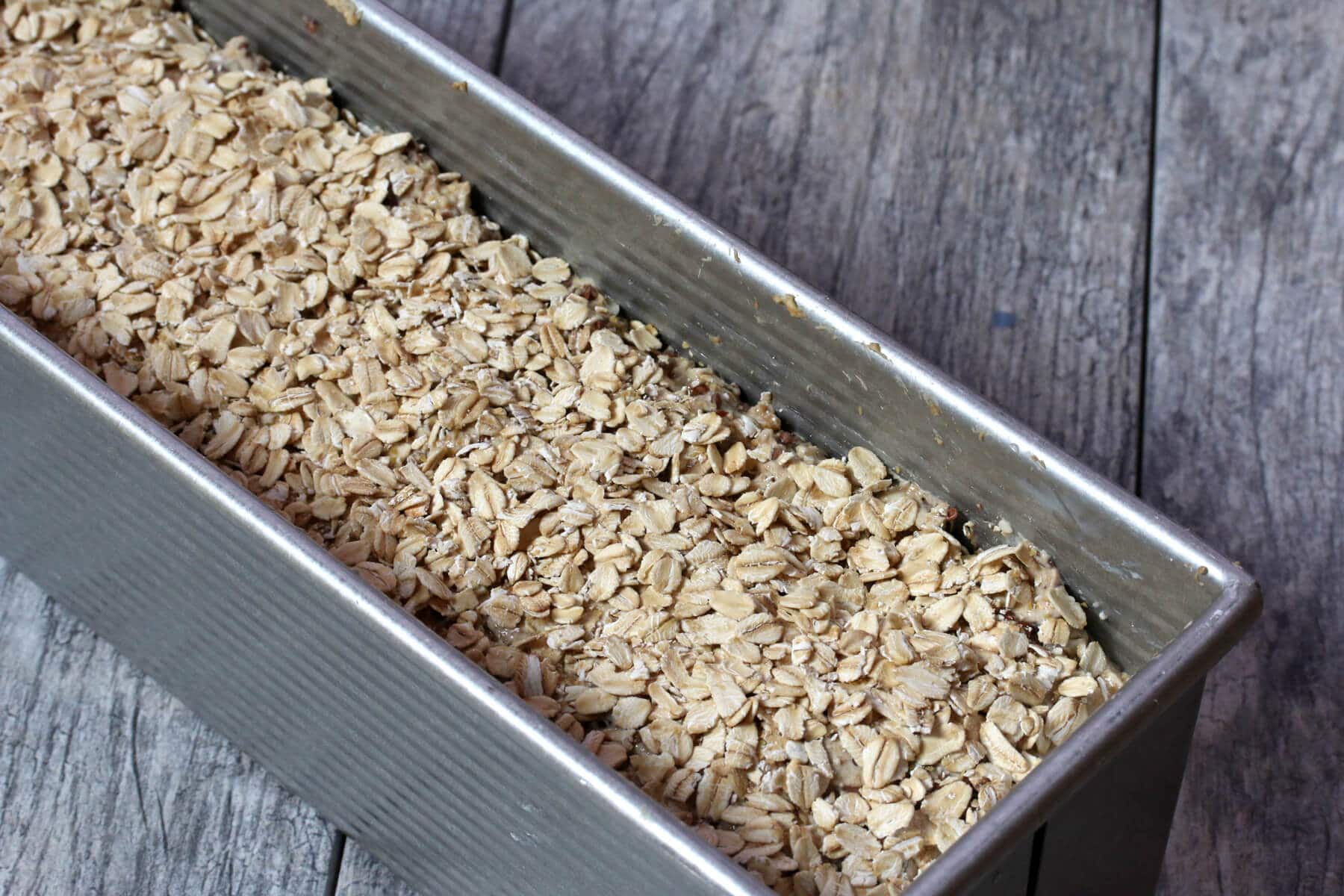
In an oven preheated to 350 degrees F, bake it on the middle rack for 100-120 minutes or until the center is done.
For best and most accurate results, use an instant read thermometer and aim for an internal temperature of 205-210 degrees F.
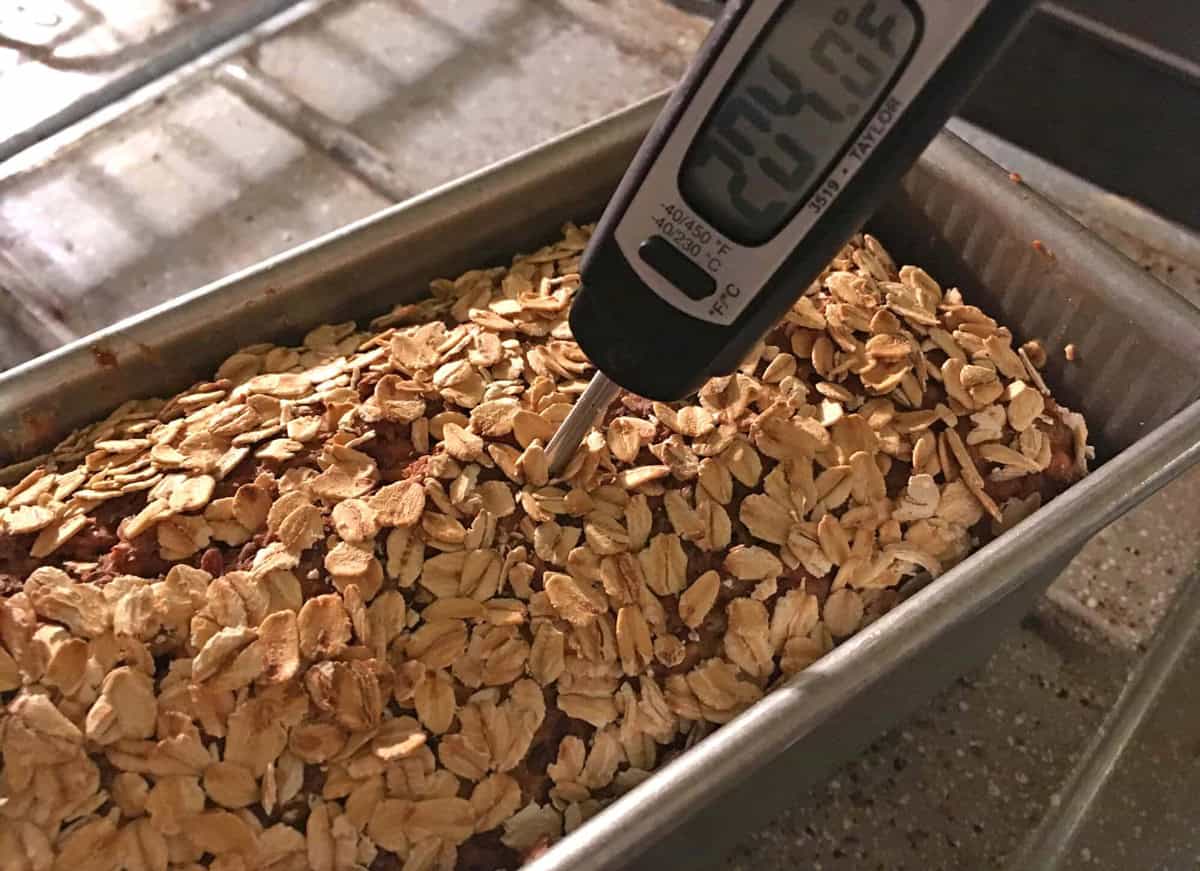
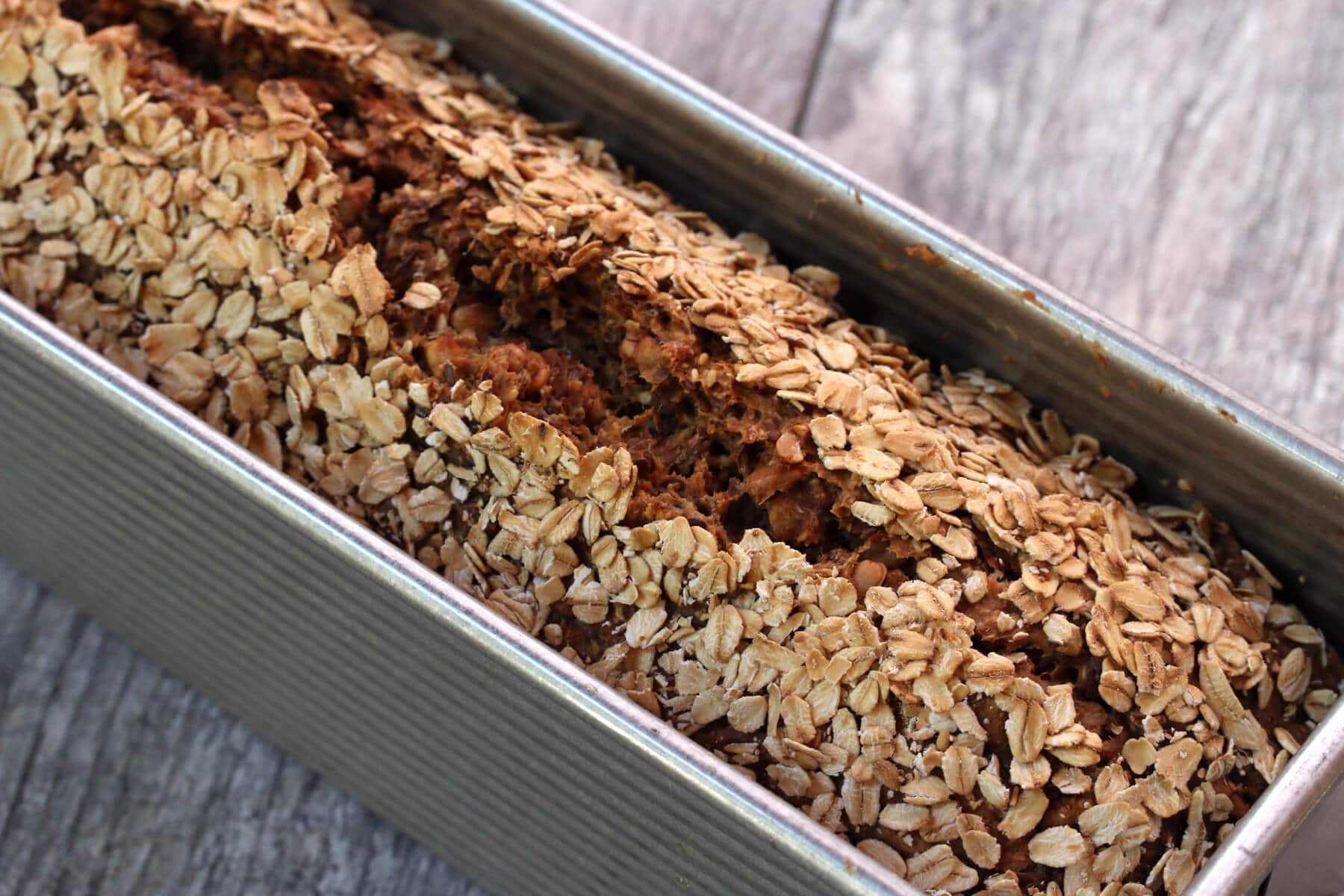
Let is sit in the pan for 5 minutes before removing it, then let it cool completely on a wire rack.
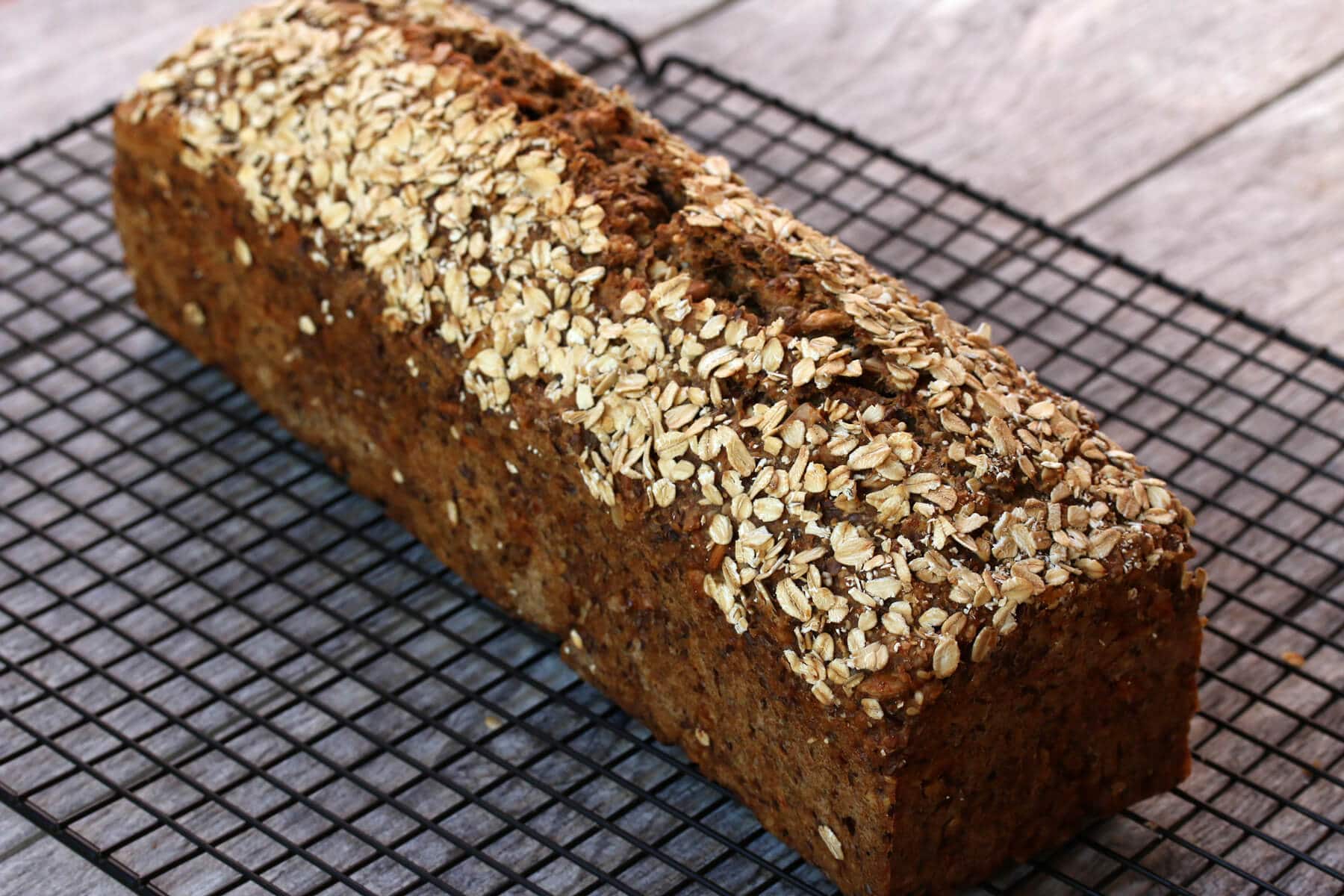
Once cooled you can slice the entire loaf in advance or slice as needed.
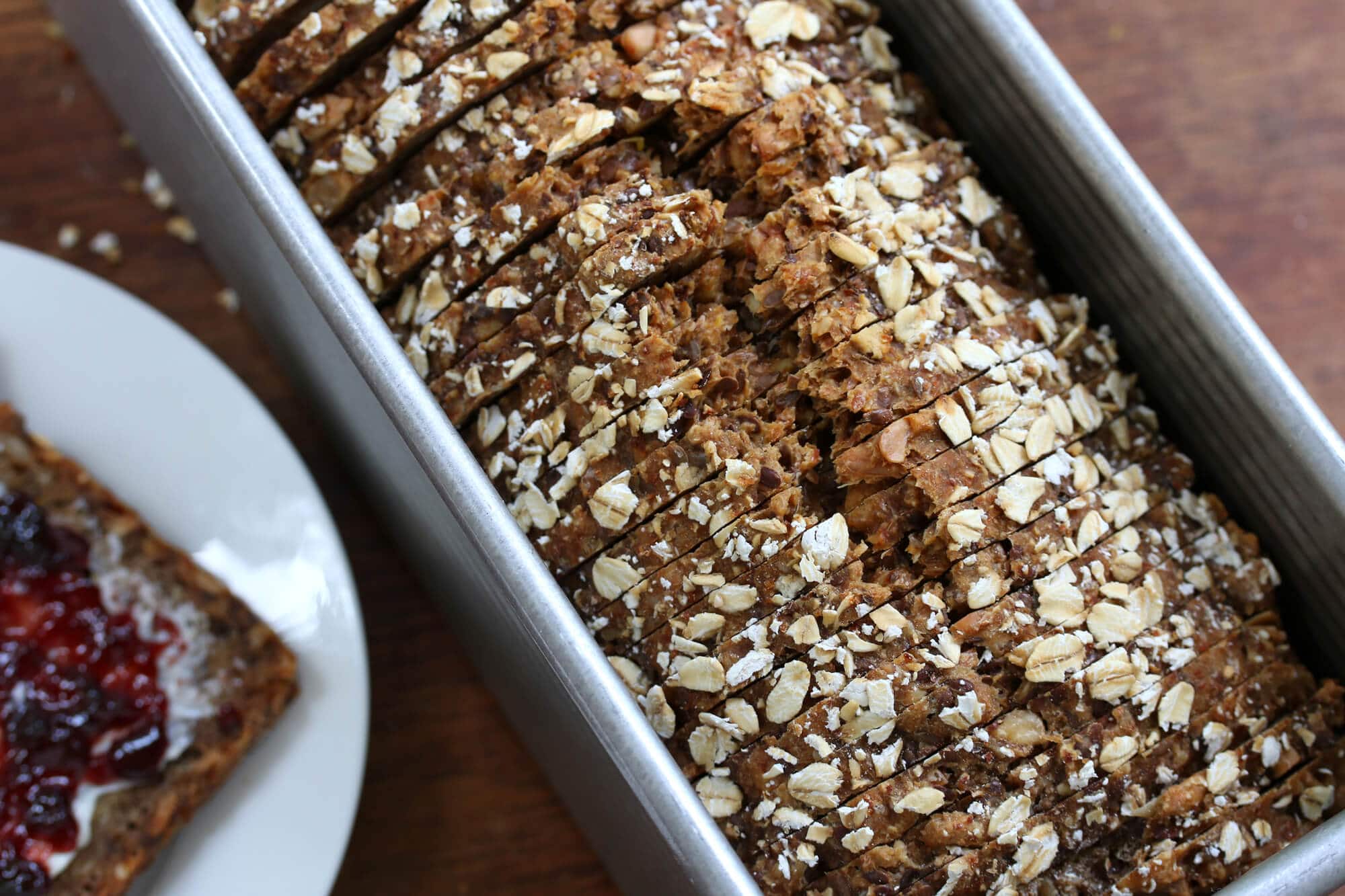
We have a decades-old Hobart commercial slicer that we picked up on Craigslist years ago. I used to be the manager of a delicatessen in England and Hobart is the gold standard in food slicers. In fact, the very same model that we have is on display at the Smithsonian!
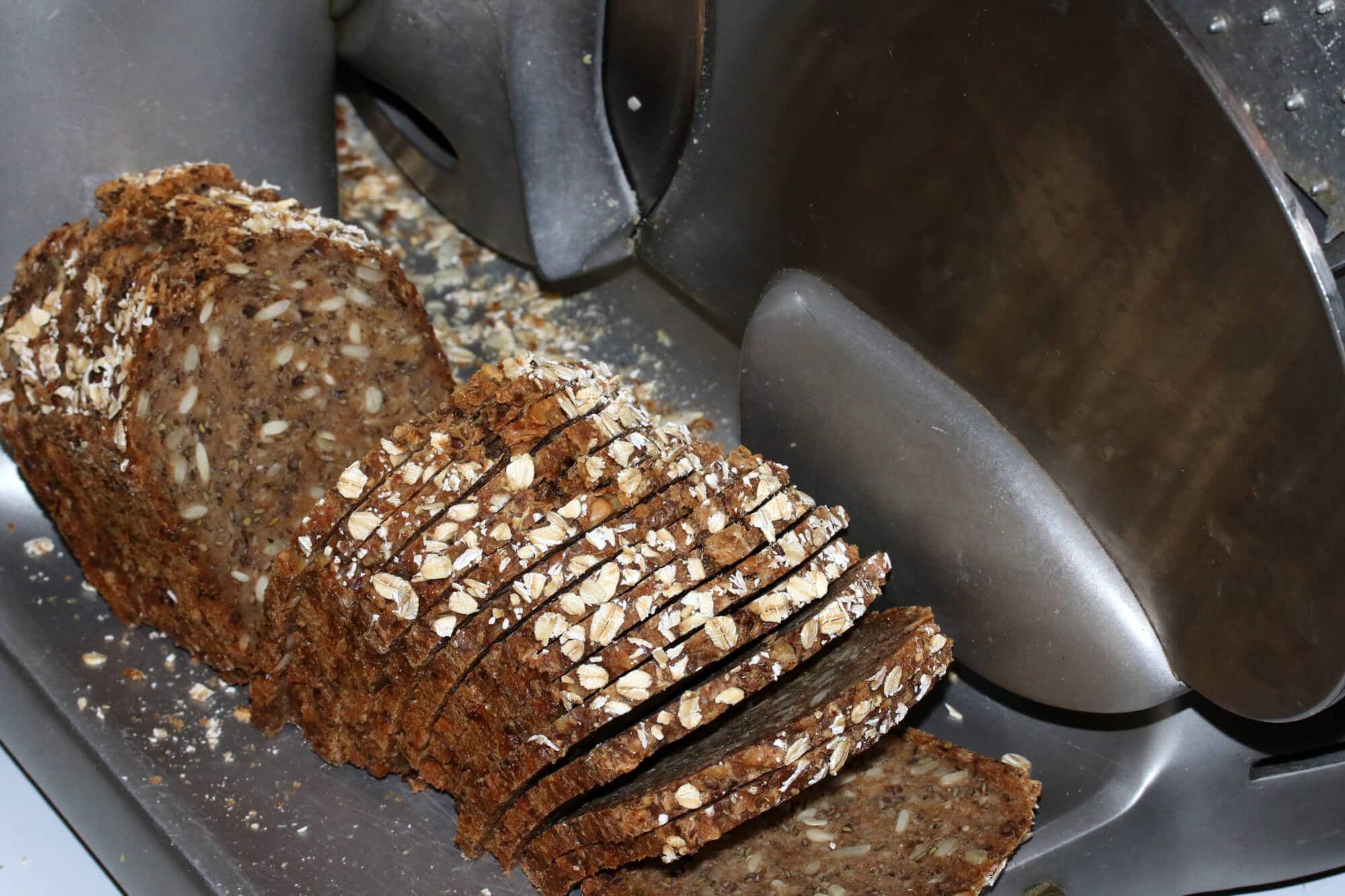
I realize we got lucky and most of you aren’t going to find a good-priced Hobart on Craigslist, but there are other good slicers on the market that are vastly cheaper and do the job. Chef’s Choice Slicers are consistently ranked at the top. I haven’t personally tried one, but they get excellent reviews. Having a good slicer to get clean, thin slices of bread that look like something you bought at a professional bakery is really nice. Plus, whenever I find chunks of cooked ham, turkey or cheese on sale I get those and slice them myself – it’s much cheaper than buying them at the deli.
At the very least you’ll need an excellent bread knife and for that my favorite knife, hands down, is the Cutco 9 3/4″ Slicer. It glides smoothly through bread and meat like no other.
Enjoy!
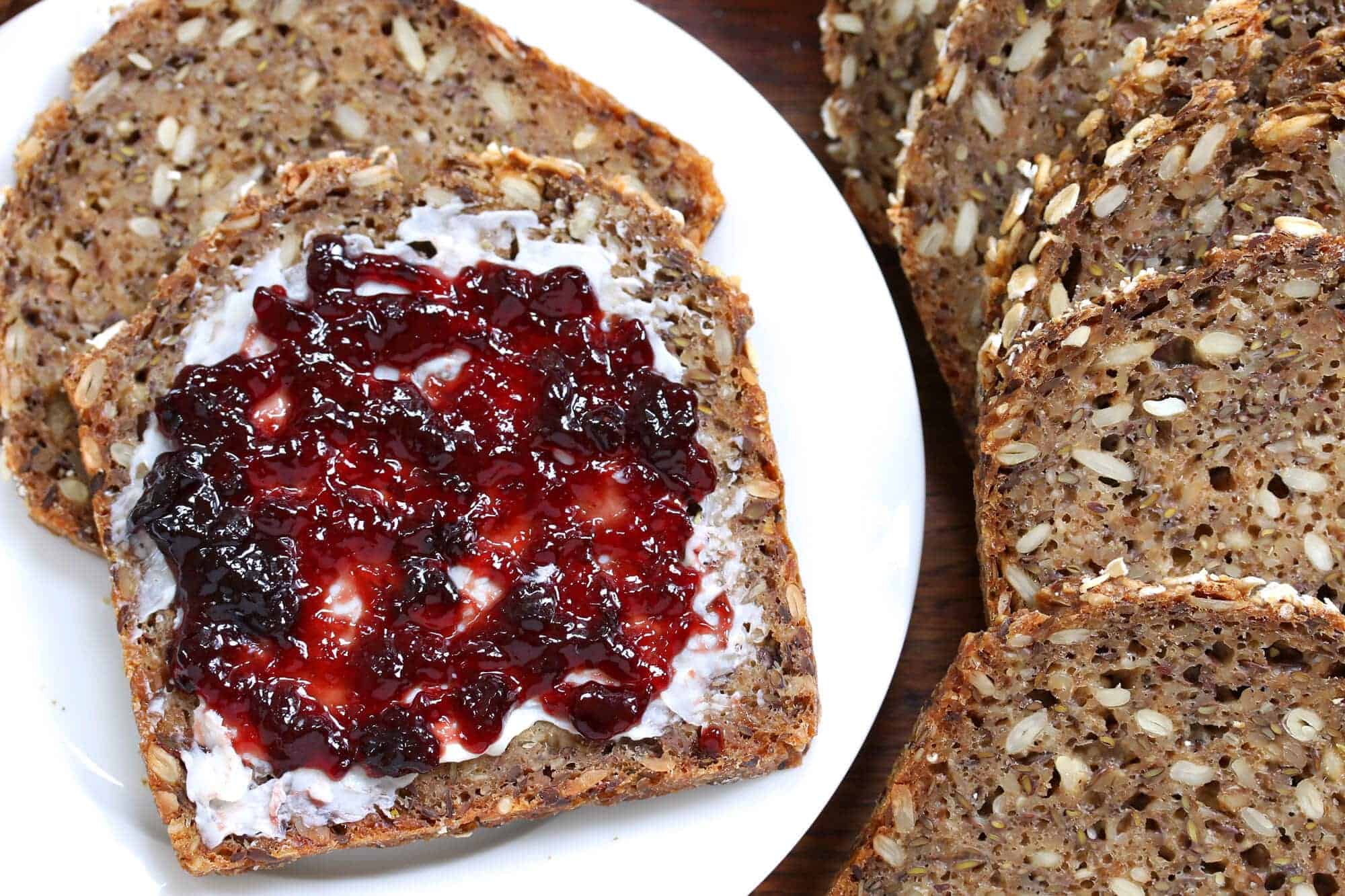
For more delicious bread from around the world be sure to try my:
- Lavash
- Injera
- Dosa
- Sourdough Naan
- Danish Rye Bread
- Crumpets
- Olive Rosemary Focaccia
- Skillet Cornbread
Save This Recipe
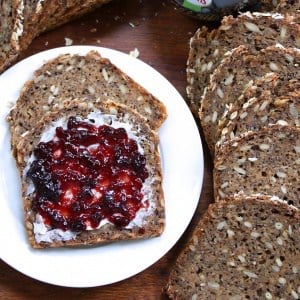
German Bread (Authentic Vollkornbrot)
Ingredients
- 4 1/2 cups einkorn flour (you can also use whole wheat, spelt, rye or combination)
- 1/2 cup whole einkorn berries , or wheat, spelt or rye berries (***See NOTE about soaking)
- 1 3/4 cups cracked einkorn berries , or wheat, spelt, rye (**See NOTE about cracking the grains **See NOTE about soaking)
- 1 cup whole flax seeds
- 1 1/2 cups sunflower seeds
- 1/4 cup sesame seeds
- 3 teaspoons salt
- 2 teaspoons dry active yeast ** see Note for sourdough substitution
- 2 tablespoons sugar , optional but recommended
- 2 cups lukewarm water
- 2 cups buttermilk , at room temperature
- 1 cup mild beer (optional, for a maltier flavor) , at room temperature (can substitute water or buttermilk instead)
- Rolled oats for sprinkling
Instructions
- Dissolve the yeast and sugar in the lukewarm water and let it sit for 5-10 minutes until frothy.
- Combine all of the dry ingredients in the bowl of a stand mixer. (You can do this by hand if you prefer.) Then add the yeast mixture along with the buttermilk and beer. Attach the dough hook and knead on the bread setting (#2) for 10 minutes. Scoop the batter into a large non-reactive bowl, cover loosely with plastic wrap, and let it sit at room temperature for at least 8 hours, preferably longer, up to 24 hours (the longer the better for the whole grain berries to soften and for heightened sourdough properties. Also the longer it ferments the more liquid will be absorbed so less chances of a moist center after baking.)
- Preheat the oven to 350 degrees F.
- Scoop the batter (it will be thick and gooey but not like regular bread dough) into a generously buttered 13x4x4 Pullman loaf pan and smooth the top to even it out. Sprinkle with oats. (Note: Baking this bread in a Pullman loaf pan yields those nice small, square slices of bread. But it also helps ensure that the center of the bread is fully cooked.) I always bake this without the lid on.
- Bake on the middle rack for 100-120 minutes or until the center is done. For best and most accurate results use an instant read thermometer and aim for 210 degrees F. Let the bread sit in the pan for 5 minutes before removing it, then let it cool completely on a wire rack before slicing it. To get clean, professional slices I highly recommend using a bread slicer.
Notes
- How to “crack” the whole berries: I use my grain mill to crack them by putting it on the coarsest setting. Another option is if you have a Vitamix and use the dry container – pulse the whole berries a few times until you get coarse pieces of einkorn. A powerful food processor will likewise do the job. Alternatively you can also place the whole berries in a ziplock bag and use a heavy object to pound them to break them up.
- Soaking the Grains: I personally don’t pre-soak the whole or cracked grain berries and just let my batter ferment for a full 24 hours which softens the berries, and I’ve always had great results. However, depending on the age of the grains you’re using (even if you just bought them they may have sat in the store or warehouse for a long time) they may require a pre-soaking in order to be adequately soft. If you wish you can pre-soak the grains overnight (pour hot water over them and let them sit) and then thoroughly draining.
- **Sourdough Substitution: To make this a sourdough Vollkornbrot omit the yeast, add 200 grams of active sourdough starter, and reduce the flour by 100 grams and the water by 100 grams. Give the batter a full 24 hour ferment.
Nutrition
Originally published on The Daring Gourmet December 11, 2019



















I’m writing to report on my success with experimenting with the recipe. As you suggested, I was mindful of making substitutions that matched the same texture of ingredients in the original recipe. I’ve made it with my substitutions twice, and each time — following your clear original instructions — the loaves came out perfectly. I did a 24 hour ferment (no pre-soak). I love this bread!!
I wanted to leave out the flax and sesame seeds, and to substitute in oat groats. I used my KoMo mill to crack and mill the grains.
I used:
575 g Einkorn, milled to a fine flour
385 g Einkorn, cracked
80 g Einkorn, whole berries
160 g whole oat groats, cracked
200 g sunflower seeds
26 g Redmond Real Salt (this is slightly more than the recipe called for, and fit my taste better)
6 g dry active yeast
24 g sugar
500 ml lukewarm water (~110–115º F)
2 cups buttermilk
1 cup water
Since I do not have a commercial slicer, I came up with a method that does pretty well (and people have marveled about how thin and regular my slices are). I set up the loaf on a cutting board, with a tall and straight-sided pitcher full of water pushed up against the right side of the loaf (off the cutting board). (I suppose it could be anything that is heavy, straight-sided, and at least as tall as the loaf). Once I do the first cut to the right end, I abut the loaf to the pitcher, and keep the pressure there to keep the slices in place as I go. This keeps the pressure on the loaf to keep it steady as I slice, and allows me to get 1/4″ slices. With the pitcher in place and a steady hand, it does pretty well. Not perfect, but pretty good! Then I divide the loaf into 4ths, and put them in separate freezer storage bags, to take out as I go through it.
The Pullman pan & the instant-read thermometer are indispensable tools.
As others have suggested, I do put the partly-cooled loaf into a plastic bag to steam (the whole grains in the crust are very hard when they are dried out). Perhaps this is not necessary; it may just moisten in storage.
I am thrilled to have this recipe! Thank you so much for posting this, and for being so helpful with questions.
Hi Jenny, thank you so very much for taking the time to leave this feedback. I’m so glad that you enjoyed this recipe and that you were able to experiment with success!
Hi All, I’m wondering if anybody reduced he amount of liquid? I didn’t use beer only water and milk. It turned out really nice. Thank you. Josephine (Ireland)
I have tried several recipes in search of the particular kind of bread that I fell in love with when I lived in Germany in the late 90’s. THIS IS IT!! The texture and flavor are exactly as I remember and to think that I was able to make this by myself is exciting beyond words. Spread with butter and jam or honey, or topped with some good cheese and cold cuts, this bread is just wonderful. THANK YOU!
That’s wonderful, Teresa! I’m so thrilled that you enjoyed it and I appreciate the feedback, thank you!
This is a great recipe, tasted just like home. I’ve experimented some with substituting seeds with great results. I’m going to try to use 2 smaller pans because I felt the large loaf was too “moist” in the center after the maximum baking time.
Thank you, Mela, I’m happy you enjoyed it and that the experimentation has been a success!
I have made this twice. I like the flavour but I have to toast it otherwise it’s doughy. It even feels sticky when I cut it and looks not done enough. I baked until the internal temperature was 208 and baked for two hours and 15 minutes. I used the proper pan. Why is it so doughy? I know how to bake but this is disappointing.
Hi Janice, did you pre-soak the grains both times? How long did you let the batter ferment?
I am German and have not found any comparable recipe to this. The bread tastes exactly like my childhood. Thank you! Where did you find this recipe? I need to make a variation without flaxseeds. Do you know of more recipes or how I can adjust it?
Thank you so much, Ricarda, I’m thrilled that you enjoyed it! This is my own original recipe, I developed it several years ago after moving the U.S. and missing German bread. You can omit the flaxseeds and use an additional cup of cracked einkorn (or wheat/rye) in its place.
Hi, Can I use a dutch oven to bake the bread in? If so how long would you recommend?
Hi Jinni, this bread mixture is more of a batter than a dough and it will not hold shape without the bread loaf pan.
I have a measurements question. I’m new to milling (I have the same Komo as you feature here), and what I’ve been reading is that freshly milled flour, since it has not settled in transit, is going to be fluffier, and so recipes need to take that into account when going by volume. I’ve read that one needs to add about 2 tablespoons of flour to match the amount in a cup of store-bought flour, to account for the volume change once the flour settles.
Can you please give some guidance about what your measurement instructions here reference — i.e., freshly milled and more fluffy flour, or, flour that’s had a chance to settle a bit? When I use freshly milled and measure by volume, I have been tapping the side of the cup to get it to settle in a bit…with mixed results. (I assume that given the bulk, the cracked Einkorn will remain about the same if done fresh.)
Or, better yet, if you have ever weighed the Einkorn prior to milling into flour, I would appreciate that measurement.
Thank you for any tips about measurements and fresh milling!
Hi Jenny! Yes, you’re exactly right about freshly milled flour. This recipe assumes that the flour is “settled” because most of my readers making this do not have a mill and are using pre-ground flour. However I do also provide the metric measurements which will eliminate the issue you described with freshly milled flour because it will allow you to measure by weight instead of volume. To the right of the list of ingredients you’ll see a button for “Metric” that you can click. Happy baking! :)
Ah, now I see the measurements options! Thank you so much, that will help a lot.
I had asked a question previously and don’t know if you missed it so I will restate it here. I see above that you spoke to substituting flax for more cracked Einkorn. I was curious to try the recipe to be all Einkorn (flour, cracked, and whole berries), to mimic a delicious bread I bought at a bakery last year (which they called Einkorn Brot). While I can see that it’s probably a good idea to make the recipe as-is for a first go to get the feel of how you intended it, I wonder if you can comment on the idea of substitutions. I have been assuming that if I took out the sesame and flax, I’d just need to exchange for the same mass — but I don’t know if using the cracked Einkorn, or whole berries, is best for the texture etc.
Do you have any advice? Maybe try both? (cracked for flax, more berries for sesame, just to keep a balance?)
Ultimately, I guess the question is about the best way to substitute for mass/weight.
I’m very eager to try; your recipe is the closest I’ve found in extensive internet searches!
Hi Jenny, there is definitely some flexibility in this recipe for substitutions but I’m always hesitant to make certain recommendations without actually testing them. Generally I recommend using cracked Einkorn in place of the flax or seeds. There is a textural component in addition to the weight. In the end though, as with any substitutions one might make to this bread, there will have to be some experimentation to know what works well.
This recipe made the most amazing bread. It was my very first attempt at baking any bread and I cannot even believe how well it turned out. My oven needed a few extra minutes to bring the loaf to temperature but other than that the instructions worked wonderfully. The taste is authentically German. I love every bite. Thank you for sharing this terrific recipe!
That’s fantastic, Connie, I’m thrilled that you enjoyed it and congratulations on your first – and totally successful – attempt!!
ps to my first comment
I see on the ingredient list from the bakery whose bread I liked that they only list this:
Organic einkorn flour, water, organic cracked einkorn, organic sprouted einkorn, organic whole einkorn, and salt.
(No idea where the yeast is in this…unless they have not listed it or another sourdough starter?)
So, I see that it can work if one is not in the mood for all of the seeds (I’m sure I’ll try that too at some point).
If I go by weight, I am guessing I can substitute by volume, but that is where I’m hoping you might be able to offer some advice.
Thanks!
Hello, I’m happy to have found this recipe after having some good Einkorn bread from a bakery.
The bread I had and liked did not have flax and sesame (nor sunflower seeds, but I like those).
Can you please comment on how to make the recipe work without those two seeds? (If you think it can.) Would I just make up for the volume by increasing the soaked berries and/or cracked Einkorn?
Thank you for the great recipe post!
Very good recipe! I keep a lot of grains on hand (I grind my own flour) as well as seeds otherwise it would be too much of a hassle to make. Love it toasted with cream cheese and everything bagel seasoning.
Fantastic, Willow, thank you so much!
I had great hopes for this recipe since I loved the bread while in Germany. Unfortunately, this bread taste odd. It’s got kind of a bitter taste, or maybe too much salt. I had my doubts about adding 3 teaspoons of salt. It’s a taste you can’t mask even with Jim. Combined with the expensive pullman pan and the pricey ingredients that had to be ordered this is one expensive loaf. I would like to try it again, but I don’t know what I could change to fix it.
Hi Patricia, the salt isn’t the issue, that won’t make the bread bitter. If you find it too bitter it’s one of two things (or both): 1) the beer and 2) the fermentation time. Some beers are more bitter than others. The longer the batter ferments, the more fermented it will taste which you may be equating with a bitter flavor. So I would address one of those two things. I recommend starting with the beer: either change the kind of beer you’re using or omit the beer entirely (I would probably try that first) and see what you think of the results.
If i wanted to use sourdough starter instead of yeast, how much would I use?
Be careful if converting to metric: two teaspoons of yeast is only approximately 9 grams, not the 24 grams that the recipe states, which would be almost three times the amount of yeast needed.
I made this bread (using 9 grams of yeast) and it turned out very well. I lived in Germany and this tastes like real German Vollkornbrot. Great toasted!
Oh goodness, thanks for catching that, George. That’s a third party software that automatically makes those conversions and I have no idea how it was so off. It should be about 6 grams. Thanks for the feedback, George, I’m so glad you enjoyed the bread!